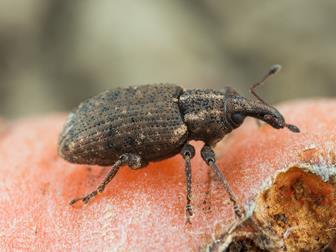
Gorgojos
Carrot Weevil
Listronotus Dauci
Pathogen:
Insect
Type:
Risk to the plant:
INTERMEDIATE



DESCRIPTION
WHO CAUSES IT?
Listronotus dauci is a beetle belonging to the family Curculionidae, commonly known as the carrot weevil. This insect goes through several stages in its development: egg, larva, pupa and adult. Adults emerge in spring and search for carrots to feed on and lay their eggs in the nearby soil. The larvae hatch and move to the roots of the carrots, where they feed and develop. After completing their larval development, they pupate in the soil and eventually emerge as adults to restart the cycle. Adults can live for several months, and under suitable conditions, can produce several generations per year.
SYMPTOMS
The carrot weevil causes a disease in carrots that can significantly affect their quality and yield. The main damage is caused by larvae feeding on the roots, which can lead to deformation, stunted growth and, in severe cases, death of the plant. Affected carrots show visible symptoms on both the aerial part and the roots.
- Holes and tunnels in the roots.
- Deformations and scars on carrots.
- Wilting and chlorosis of the leaves.
- Delay in plant growth.
- Loss of vigor.
- Death of young seedlings.



TEMPERATURE AND HUMIDITY
15°C - 25°C
60% - 80%

HOW IS IT SPREAD?
Movement of infected soil, crop residues, wind, insect vectors, contaminated agricultural tools, infested plants

HOW TO REMOVE IT?
Home remedies
There are no home treatments
Chemical treatments
• ORANGE OIL 60g/L [ME] P/S
• AZADIRACTIN 1% (AS AZADIRACTIN A) [EC] P/V
• Azadirachtin 2.6% (AS AZADIRACTIN A) [EC] P/V
• CYPERMETHRIN 10% [EC] P/V
• CYPERMETHRIN 5% [EC] P/V
• CYPERMETHRIN 0.8% [MG] P/P
• DELTAMETHRIN 2.5% [EC] P/V
• LAMBDA CYHALOTHRIN 10% [CS] P/V
• SPINOSAD 48% [SC] P/V
Authorized treatments in organic farming
• ORANGE OIL 60g/L [ME] P/S
• AZADIRACTIN 1% (AS AZADIRACTIN A) [EC] P/V
• Azadirachtin 2.6% (AS AZADIRACTIN A) [EC] P/V
• LAMBDA CYHALOTHRIN 10% [CS] P/V
• SPINOSAD 48% [SC] P/V
Insect allies
PREDATORY MITES
LADYBUGS
LACEWINGS
PARASITIC WASPS
HOVERFLIES OR PARASITIC FLIES
PREDATORY BUGS
There are no natural allies
Mycodiplosis oidii (predatory mosquito)
EFFECTIVE PRODUCTS TO ELIMINATE THIS DISEASE
Sponsored link
Sponsored link
Sponsored link
Sponsored link
Sponsored link
Sponsored link
Sponsored link
Sponsored link
Sponsored link
Effective against all types of fungi
Sponsored link
Sponsored link
Sponsored link
Sponsored link
Sponsored link
Sponsored link
Sponsored link
- Carry out crop rotation to avoid the accumulation of the pest in the soil.
- Plant carrots in well-drained areas to reduce the survival of larvae in the soil.
- Use soil covers or mulching to make it difficult for adults to access the plants.
- Implement deep tillage practices to expose and remove pupae from the soil.
- Regularly monitor plantations and use pheromone traps to detect and control adult populations.
- Apply specific insecticides preventively, following technical recommendations and respecting withdrawal periods.
- Promote the presence of natural enemies such as entomopathogenic nematodes that can parasitize and reduce larval populations.
























